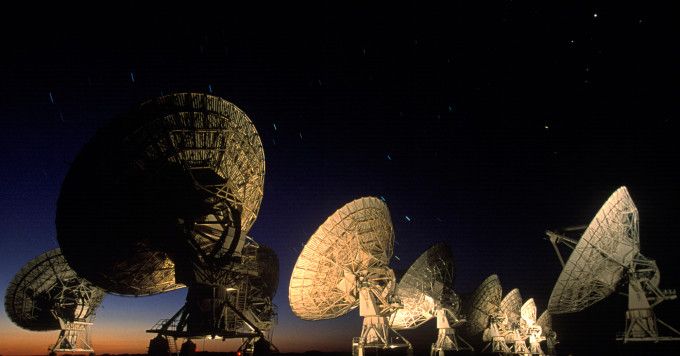Work from home caused by the coronavirus pandemic has accelerated conversations about zero-trust, several IT officials have said recently.



SYDNEY, Australia — When you look up at the night sky, which constellations can you make out? Can you spot the Big Dipper? Do you see Orion’s Belt? Counting stars is pretty difficult in areas with lots of light, like major cities. A study says even in the clearest skies, you’re still seeing turbulence in the atmosphere that makes stars twinkle. Want a truly perfect view of outer space? An international research team has found the spot, but you’ll need to bundle up. It’s in Antarctica!
Stars aren’t supposed to twinkle?
According to the University of New South Wales, turbulence causes light coming from stars to bend as it reaches the Earth’s surface. That instability in the air gives stars their trademark twinkling effect.

face_with_colon_three yay closer to foglet bodies: 3.
Is the T-1000 no longer science fiction?
It is a human dream to realize a robot with automatic mechanical functions similar to the robots presented in several science-fiction movies and series such as “Ex Machina”, “Black Mirror”, “The Terminator”, etc.
More specifically, the idea of a liquid-metal-based robot able to transform its structure from solid to liquid, slip through narrow channels, and self-repair from any physical damage has always fascinated the scientific community engaged in cutting-edge technological discoveries. Beside the science-fiction background, micromachines able to gain energy from chemical reactions are attracting lots of attention as they emerged as ideal candidates for microrobots used in the field of microfabrication, detection/sensing, and personalized drug delivery.

Scientists are ramping up their efforts in the search for signs of alien life.
Experts at the SETI Institute, an organization dedicated to tracking extraterrestrial intelligence, are developing state-of-the-art techniques to detect signatures from space that indicate the possibility of extraterrestrial existence.
These so-called “technosignatures” can range from the chemical composition of a planet’s atmosphere, to laser emissions, to structures orbiting other stars, among others, they said.
Drone companies like DJI, Aerones, and Walkera are thinking about how drones can soon revolutionize the way we fight fires.

:33333
A comet has been captured on camera streaking across the skies over Stonehenge.
Comet Neowise has been spotted by stargazers across the UK and around the world as it heads past Earth.
It was discovered in late March and became one of the few comets in the 21st century that can be seen with the naked eye as it approached the sun.

Invisible radio signals from the cosmos have revealed previously unknown phenomena from prebiotic molecules in a starburst about 250 million light-years from Earth to the true rotation of Mercury. But the most famous occurred on August 6, 1967, when a squiggly stretch of high-speed recordings occupying less than a quarter-inch of astronomer Jocelyn Bell Burnell’s radio-telescope readouts revealed the first sign of something strange — an unknown cosmic mystery.
The minuscule signal appeared over and over again in the same part of the sky and she realized she was looking at a cosmic mystery — a repeating string of radio pulses spaced a bit more than a second apart that were unlike anything anyone had ever seen before. Bell-Burnell had detected the first evidence of a pulsar LGM-1 for Little Green Men. They thought the pulses could possibly be a beacon from an alien source.
Fast forward to today — mysterious circles of radio waves have left astronomers who are part of a pilot survey for a new project called the Evolutionary Map of the Universe (EMU) baffled with no idea how they formed, or even how big or far away they are. They don’t seem to match anything that has been seen before in the cosmos. The researchers dubbed them Odd Radio Circles, or ORCs.

The presence of outliers in a classification or regression dataset can result in a poor fit and lower predictive modeling performance.
Identifying and removing outliers is challenging with simple statistical methods for most machine learning datasets given the large number of input variables. Instead, automatic outlier detection methods can be used in the modeling pipeline and compared, just like other data preparation transforms that may be applied to the dataset.
In this tutorial, you will discover how to use automatic outlier detection and removal to improve machine learning predictive modeling performance.
“We need to go to space to help us here on Earth. Satellites have played an enormous role in improving the state of the world, and will do even more”.
I’m often asked: ‘Why are you building satellites for space when there are so many problems to fix here on Earth?’ It’s a perfectly rational question. The short answer is that we need to go to space to help us here on Earth. Satellites have played an enormous role in improving the state of the world, and will do even more as an explosion of technology innovation enables large new fleets of small satellites to be deployed with radical new capabilities.
The Sustainable Development Goals (SDGs, or Global Goals), unanimously adopted at the United Nations in 2015, are a great summary of the world’s current challenges. Space is one of many important tools that can be used to help us address them. In May, the UN held a meeting on Technology Innovation and the Global Goals, and I was asked to address the role of satellites in helping the world achieve the SDGs.
The global coverage of satellites offer a unique, fact-based perspective that can help us overcome our greatest challenges. Information from these spacecraft can help us improve agricultural yields and protect habitat loss and stop deforestation. They discovered the hole in the ozone layer and their data today remains key to fighting climate change; and they’ve helped us to connect the world through internet and communication, an intangible service for millions. Satellites in space have done much for us so far and, in the future, they will offer much more.

One idea, which has been in gestation for some years, could be about to have its break-out moment. A new agreement, the Treaty on the Prohibition of Nuclear Weapons (TPNW), is expected to become international law next year — and scientists have a chance to play a part in helping it to succeed.
Seventy-five years after the bombing of Hiroshima and Nagasaki, a new treaty offers renewed hope for a nuclear-free world.